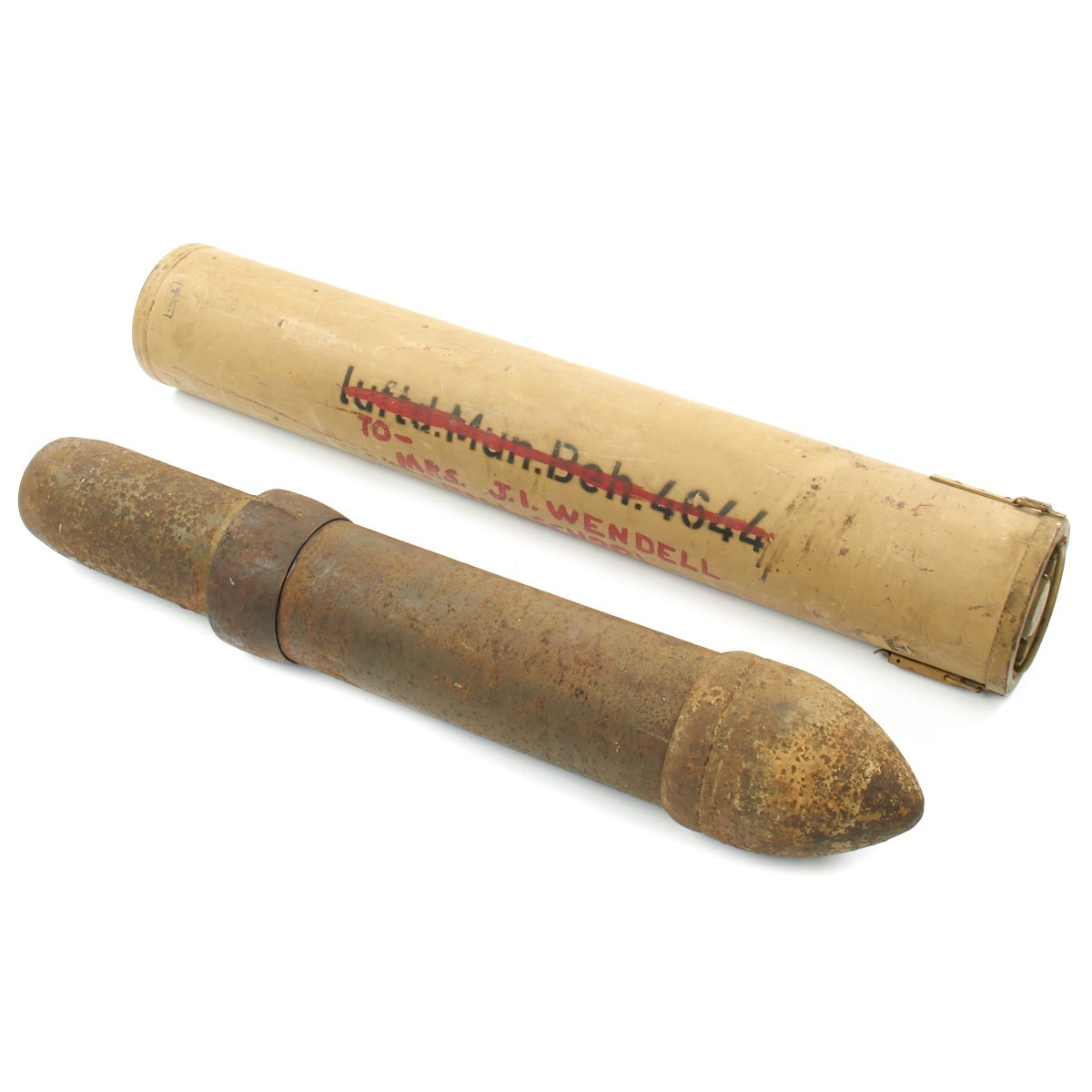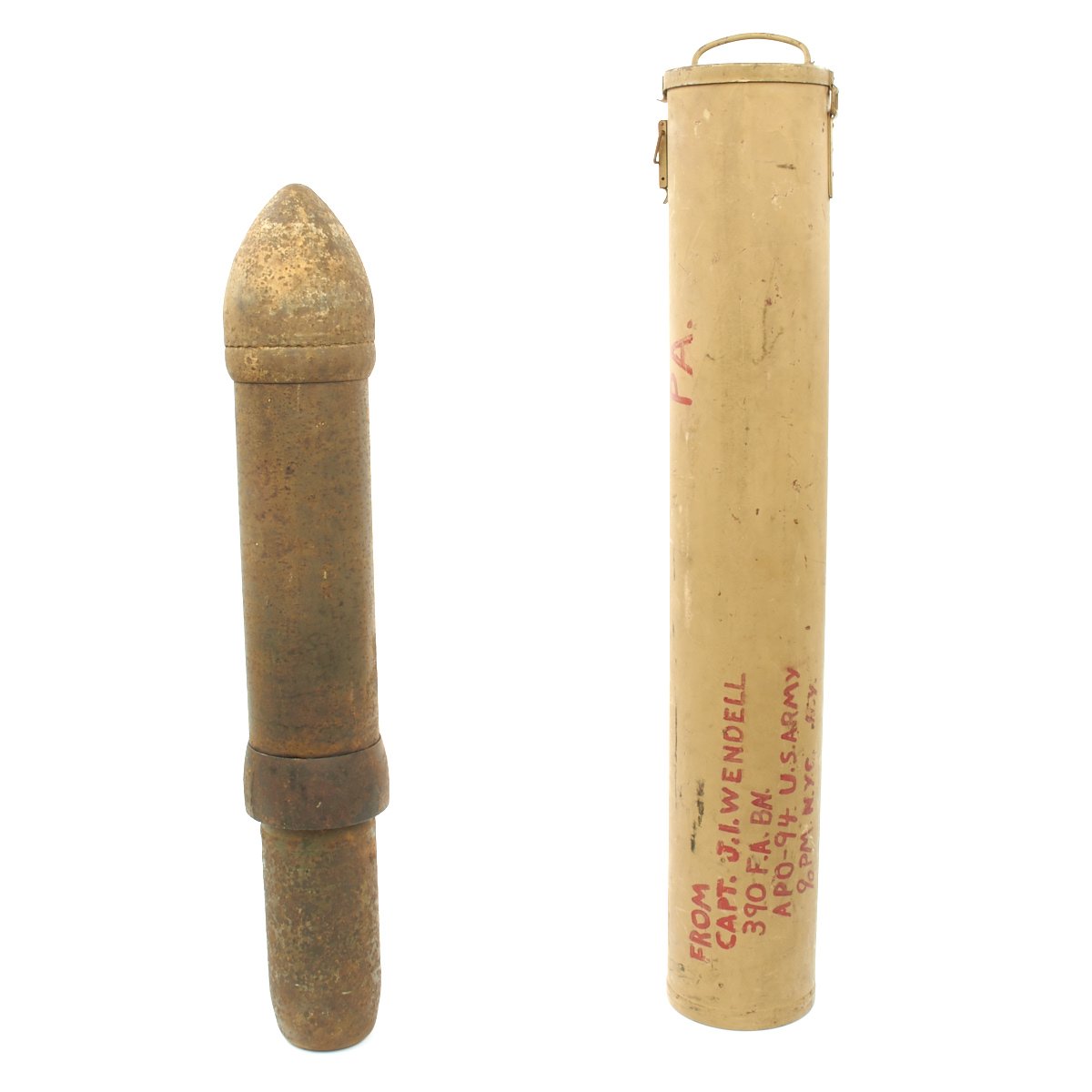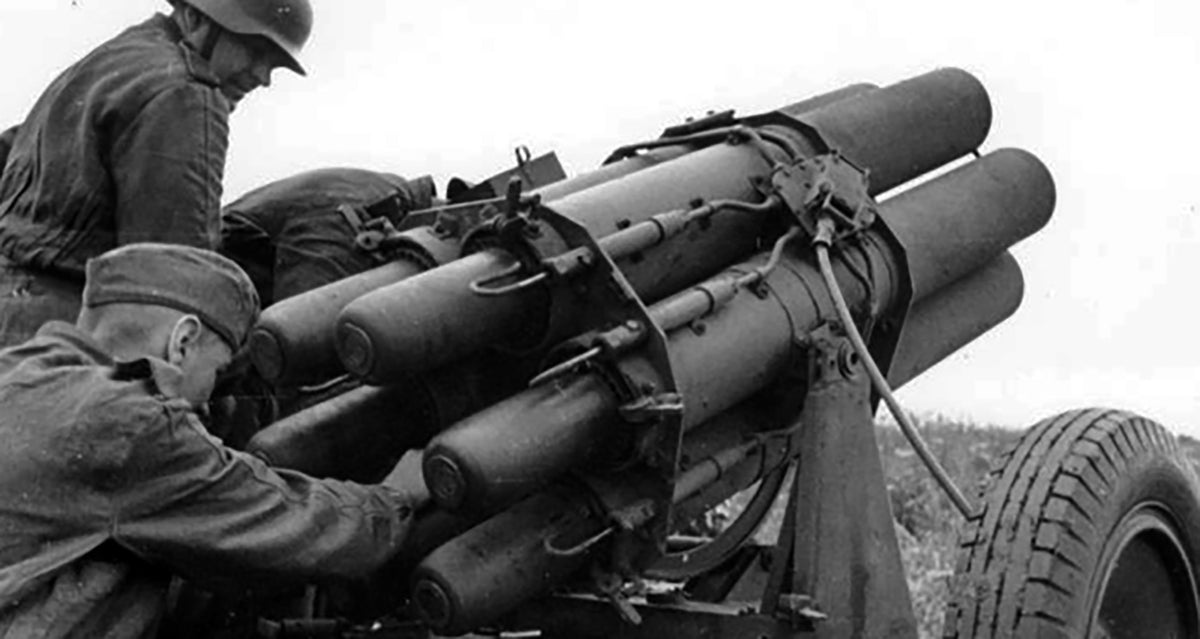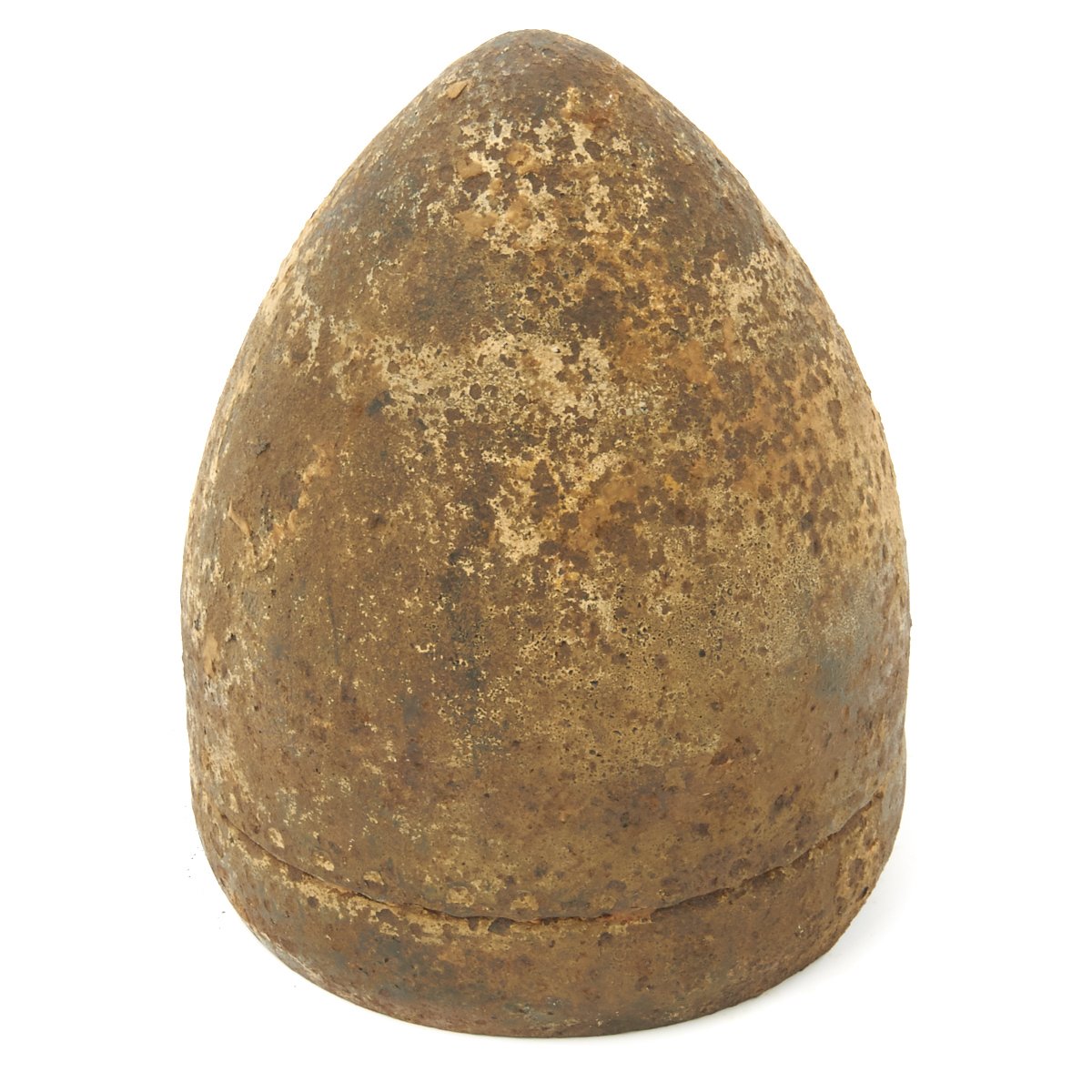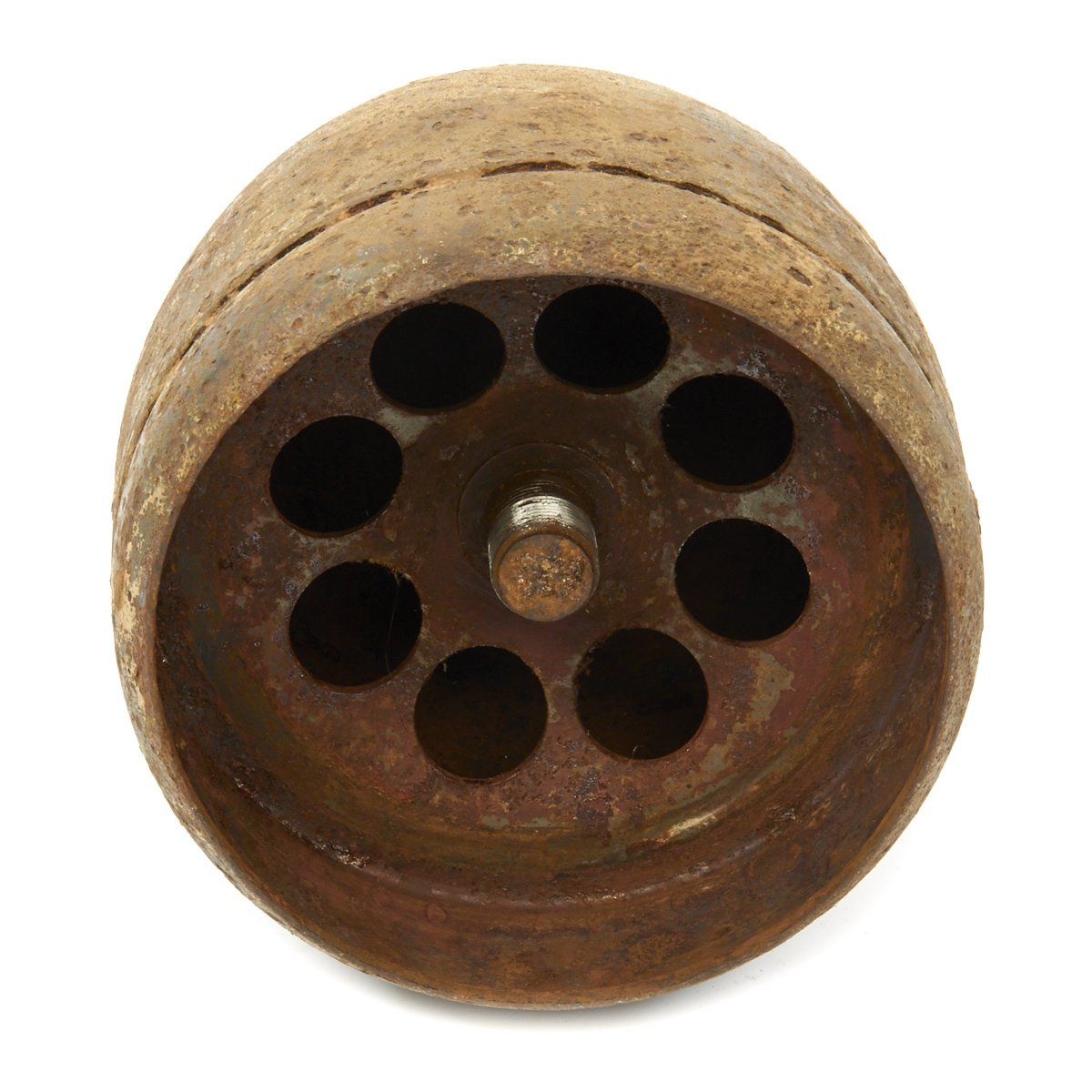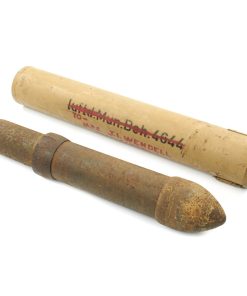Original German WWII 15cm Nebelwerfer 41 Inert Rocket with Transit Tube – USGI Bring Back Original Items
$ 2.295,00 $ 573,75
Original Item: Only One Available. This round is inert and follows guidelines provided by the ATF. The German designation Nebelwerfer, (Smoke Launcher), was actually a camouflage term used to hide the development of rocket launchers which had been banned as a result of the Treaty of Versailles following the end of WWI. Under the camouflage term German armament firms continued development of rocket launchers which fired smoke or high explosive shells in direct violation of the Treaty. In 1941 the 15cm Nebelwerfer 41 was introduced and it would be come the standard weapon utilized by the Nebeltruppen. The Nebelwerfer 41 consisted of six firing tubes mounted on a two wheeled split trail carriage. The 15 cm Nebelwerfer 41 (15 cm NbW 41) was a German multiple rocket launcher used in the Second World War. It served with units of the Nebeltruppen, German Chemical Corps units that had the responsibility for poison gas and smoke weapons that were also used to deliver high-explosives during the war. The name Nebelwerfer is best translated as “smoke mortar”. Allied troops nicknamed it Screaming Mimi and Moaning Minnie due to its distinctive sound.
Rocket development had begun during the 1920s and reached fruition in the late thirties. This offered the opportunity for the Nebeltruppen to deliver large quantities of poison gas or smoke simultaneously. The first weapon to be delivered to the troops was the 15 cm Nebelwerfer 41 in 1940, after the Battle of France, a purpose-designed rocket with gas, smoke and high-explosive warheads. It, like virtually all German rocket designs, was spin-stabilized to increase accuracy. One very unusual feature was that the rocket motor was in the front, the exhaust venturi being about two-thirds down the body from the nose, with the intent to optimize the blast effect of the rocket as the warhead would still be above the ground when it detonated. This proved to greatly complicate manufacture for not much extra effect and it was not copied on later rocket designs. It was fired from a six-tube launcher mounted on a towed carriage adapted from that used by the 3.7 cm PaK 36 and had a range of 6,900 meters (7,500 yd). Almost five and a half million 15 cm rockets and 6,000 launchers were manufactured over the course of the war.
Inert rocket example is dated 1944 and bears the manufacturer code gud. Round is approximately 37″ tall constructed in steel with three main sections which can be taken apart. Overall condition is excellent with areas of minor pitting. A similar example can be found at the Smithsonian National Air and Space Museum as seen at this link; Rocket, Surface-to-Surface, Nebelwerfer 15cm Wgr. 41 Spr.
Transit Tube is approximately 40 1/2″ tall, cylindrical, steel construction canister with a 6 3/4″ diameter. The canister was designed to contain one 15cm Rocket Launcher M41 shell. The canister has steel fittings to both the top and bottom ends. The top steel fitting has a heavy metal, swivel hinged carrying handle and a fold back pressure locking clip. The metal fittings have minor spotting and pitting. Bears original paint. The stenciled script includes, “Luftd. Mun. Beh. 4644” (Air tight munitions container 4644) which was crossed over for transit back to the USA. In red paint there are two addresses as follows:
FROM
CAPT. J.I. WENDELL
390 F.A. BN
APO-94 U.S. ARMY
C/O PM. N.Y.C. N.Y.
TO-
MRS. J.I. WENDELL
HILL SCHOOL
POTTSTOWN,
P.A.
Research has revealed the Captain James Issac Wendell, Jr. was a medical student at the University of Pennsylvania before enlisting. A copy of his draft registration card is attached.
The 390th Field Artillery Battalion (155mm Howitzer) was part of the 94th Infantry Division. Following a brief stay in England, the 94th landed on Utah Beach, France on D-Day + 94, 8 September 1944, and moved into Brittany to relieve the 6th Armored Division and assume responsibility for containing some 60,000 German troops besieged in their garrisons at the Channel ports of Lorient and Saint-Nazaire. The 94th inflicted over 2,700 casualties on the enemy and took 566 prisoners before being relieved by the 66th Infantry Division on New Year’s Day 1945.
As part of General George Patton’s United States Third Army, the 94th Infantry Division (“94th ID”) was known as “Patton’s Golden Nugget”. Moving east, the division relieved the 90th Infantry Division on 7 January 1945, taking positions in the Saar-Moselle Triangle south of Wasserbillig, facing the Siegfried Switch Line. Fresh for the fight, the 94th shifted to the offensive, 14 January, seizing Tettingen and Butzdorf that day. The following day, the Nennig-Berg-Wies area was wrested from the enemy, severe counterattacks followed, and it was at Nennig that the Germans gave the division its nickname “Roosevelt’s Butchers” for stacking the dead in houses and along roads and refusing prisoners, lacking the means to guard and transport them. Butzdorf, Berg, and most of Nennig changed hands several times before being finally secured. On the 20th, an unsuccessful battalion attack against Orscholz, eastern terminus of the switch position, resulted in loss of most of two companies. In early February, the division took Campholz Woods and seized Sinz. On 19 February 1945, supported by heavy artillery and air support, the division launched a full-scale attack with all three regiments, storming the heights of Munzigen Ridge, to breach the Siegfried Line switch-line defenses and clear the Berg-Munzingen Highway.
Moving forward, the 94th Infantry Division and the 10th Armored Division secured the area from Orscholz and Saarburg to the confluence of the Saar and Moselle Rivers by 21 February 1945. At Ayl, General Patton ordered troops to cross the Saar immediately, against the advice of many of his officers. Under command of Lieutenant Colonel William A. McNulty, the 94th’s 3rd Battalion crossed the icy and swollen Saar on February 23, 1945.
Despite Lt. Col. McNulty’s own preparatory reconnaissance in absence of other adequate intelligence and undertaken at considerable personal risk, many men and materiel were lost during the very ill-prepared Saar crossing. Two of the three crossings sites were eventually abandoned due to heavy and pinpoint German artillery and machinegun fire.[2][3] After establishing a bridgehead at Serrig, the 376th Infantry Regiment was detached to assist the 10th Armored Division in the capture of Trier. By 2 March 1945, the division stretched over a 10-mile front, from Hocker Hill on the Saar through Zerf, and Lampaden to Ollmuth. A heavy German attack near Lampaden achieved penetrations, but the line was shortly restored, and on 13 March, spearheading XX Corps, the division broke out of the Ruwer River bridgehead by ford and bridge. Driving forward, the 94th reached the Rhine on 21 March, where it fought in the Battle for Ludwigshafen. Ludwigshafen was taken on 24 March, in conjunction with Combat Command A of the 12th Armored Division.
The division then moved by rail and motor to the vicinity of Krefeld, Germany, relieving the 102nd Infantry Division on 3 April and assuming responsibility for containing the western side of the Ruhr Pocket from positions along the Rhine. With the reduction of the pocket in mid-April, the division was assigned military government duties, first in the Krefeld and later in the Düsseldorf areas.
By mid-April, the division relieved the 101st Airborne Division and assumed military government duties, first in the Krefeld vicinity and later around Düsseldorf. It was in that status when hostilities were declared at an end on 7 May 1945. From mid-June until the end of November, the division served the military government in Czechoslovakia.
The 94th Infantry Division was inactivated at Camp Rucker, Alabama on 9 February 1946.
Fast Shipping with Professional Packaging
Thanks to our longstanding association with UPS FedEx DHL, and other major international carriers, we are able to provide a range of shipping options. Our warehouse staff is expertly trained and will wrap your products according to our exact and precise specifications. Prior to shipping, your goods will be thoroughly examined and securely secured. We ship to thousands clients each day across multiple countries. This shows how we're dedicated to be the largest retailer on the internet. Warehouses and distribution centres can be located throughout Europe as well as the USA.
Note: Orders with more than one item will be assigned a processing date depending on the item.
Before shipping before shipping, we'll conduct a thorough inspection of the items you have ordered. Today, the majority of orders will be delivered within 48 hours. The delivery time will be between 3-7 days.
Returns
The stock is dynamic and we cannot completely manage it because multiple stakeholders are involved, including our factory and warehouse. So the actual stock may alter at any time. It's possible that you may not receive your order once the order has been made.
Our policy is valid for a period of 30 days. If you don't receive the product within 30 days, we are not able to issue a refund or an exchange.
You can only return an item if it is unused and in the same state as the day you received it. You must have the item in its original packaging.
Related products
Uncategorized
Uncategorized
Uncategorized
Angolan Rebel 1970s era 60mm Inert Display Mortar from Angolan Civil War Original Items
Uncategorized
Uncategorized
Uncategorized
Uncategorized
Australian WWII Owen MK1 Machine Carbine SMG Custom Fabricated Replica with Sling Original Items
Uncategorized
Uncategorized
Band of Brothers ORIGINAL GERMAN WWII Le. F.H. 18 10.5cm ARTILLERY PIECE Original Items
Uncategorized
Uncategorized
Uncategorized
Uncategorized
Uncategorized
